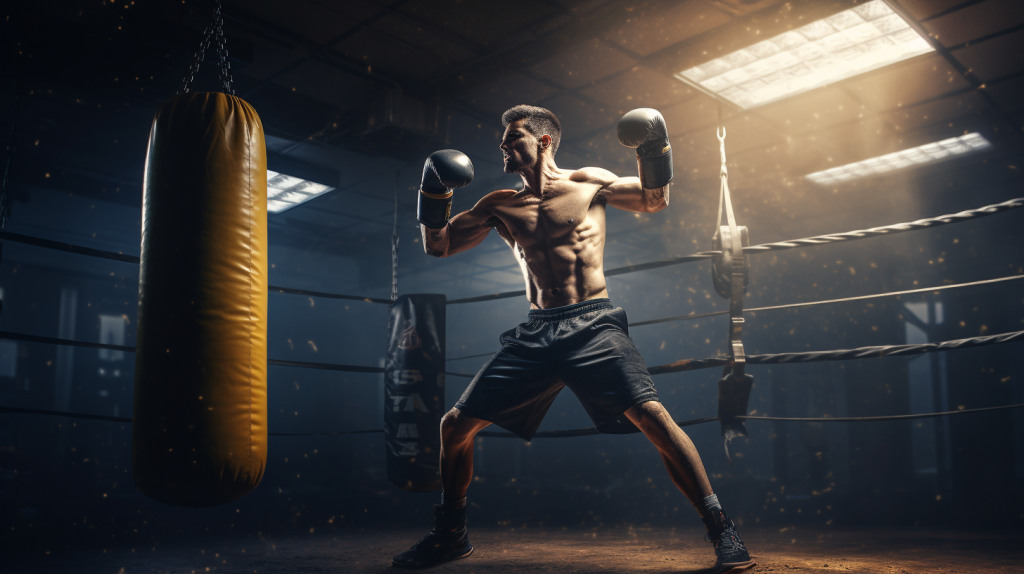Geschatte leestijd: 4 minuten
Recent research has demonstrated a strong correlation between punching power and muscle strength in boxers. Especially the strength of the leg muscles was found to have a significant effect on punching power. The findings will soon be published in the Journal of Strength & Conditioning Research [1].
Increasing Punching Power
In the article “Strength Training for Combat Sports,” I extensively discuss the importance of explosive strength in combat sports. It is clear that punching power is one of the most important variables in sports like boxing, where the match can literally be ended with one knockout punch [2,3,4].
The impact of a punch is determined by the speed at which it is delivered combined with the mass behind it. For example, you can punch purely from your chest, triceps, and shoulders for a quick punch that scores but doesn’t impress your opponent. Alternatively, you can choose to generate power from your toes, engaging your leg and core muscles to throw more mass into the fight. This will have more impact but also take more time. Previous research has confirmed that a palm strike from martial arts like Kung Fu and Karate hits harder when stepping into it rather than not stepping into it [5]. More mass, but also more time.
Therefore, Brazilian researchers aimed to measure the correlation between the strength of the chest, shoulders, and triceps and punching power, but also the correlation between punching power and the strength of the leg muscles.
Measuring Punching Power
Brazilian researchers measured the punching power of 15 amateur boxers from the Brazilian National Team (9 men and 6 women) across different weight classes from flyweight to heavyweight. These were experienced boxers, including one Olympic medalist. They had the boxers perform four different punches three times each.
- Jab from a fixed position (straight punch, lead hand)
- Cross from a fixed position (straight punch with dominant, rear hand)
- Jab from a self-chosen position
- Cross from a self-chosen position
Punching power was measured using a force plate.
Measuring Muscle Strength
Subsequently, the researchers had the boxers perform various exercises while measuring different variables to determine aspects such as maximum isometric strength and explosiveness.
They measured:
- How high they jumped from a squat position (“squat jump”)
- How high they jumped from a standing position (so that they could preload as if preparing to jump, “counter movement jump”)
- Average power development during the jump squat, bench press, and “bench throw” (literally bench press where you throw the weight upwards and release it at the top of the movement, focusing on explosive strength)
- Isometric strength during the squat and bench press (how much weight can you resist while in a squat position without sinking or coming up)
- “Rate of force deployment” (how quickly force is generated, explosive strength) in the squat and bench press
Results
Below are the results. On the left side of the table, we see the different strength measurements from squat jump to maximum isometric strength during squatting. At the top of the table, we see four different punches. The data itself indicates the correlation between them. It’s generally accepted that anything below 0.5 shows a weak correlation, between 0.5-0.7 a moderate correlation, 0.7-0.85 a strong correlation, and 0.85-0.95 an exceptionally strong correlation.
As we can see in the table, there is a correlation in all variables. It’s notable that the correlation between the squat exercises and punching power is the strongest, greater than the correlation between the various bench press exercises and punching power.
The main finding reported herein is that these neuromechanical measurements explain from 67 to 85% of the impact forces produced by boxers when executing different punch techniques.
When boxers punch at higher velocities, the ability to transfer the momentum of force from the legs to the arms is determinant in achieving high values of impact. This is consistent with our results that showed ≈ 82% of shared variance between lower limb muscle power assessed in the jump squat exercise (MPP JS) and all performed impact-tests. Importantly, among the 4 variables collected in maximal isometric assessments (MIF BP, MIF Squat, RFD BP and RFD Squat), only MIF Squat presented significantly high correlations with punching impact…, reinforcing the importance of the lower limbs in applying force during punches.
(MPP=mean propulsive power, JS=Jump Squat, MIF=Maximum Isometric Force, BP= Benchpress, RFD=Rate of Force Deployment)
Practical Applications
You can apply strength training in various ways to combat sports. You can go for maximum strength and train with heavy weights. However, you also need speed and can choose to train explosively with lighter weights. The research shows that both contribute to increased punching power and thus both need to be trained.
In addition, the significant importance of strong leg muscles has become clear.
References
- Loturco, Irineu; Nakamura, Fabio Yuzo; Artioli, Guilherme Giannini; Kobal, Ronaldo; Kitamura, Katia; Cal Abad, Cesar Cavinato; Cruz, Igor Freitas; Romano, Felipe; Pereira, Lucas Adriano; Franchini, Emerson. STRENGTH AND POWER QUALITIES ARE HIGHLY ASSOCIATED WITH PUNCHING IMPACT IN ELITE AMATEUR BOXERS.Journal of Strength & Conditioning Research:Post Acceptance: June 18, 2015 doi: 10.1519/JSC.0000000000001075 Original Investigation: PDF Only
- Lenetsky S, Harris N, and Brughelli M. Assessment and contributors of punching forces in combat sports athletes: Implications for strength and conditioning. Strength Cond J 35: 1-7, 2013.
- Pierce JD, Reinbold KA, Lyngard BC, Goldman RJ, and Pastore CM. Direct measurement of punch force during six professional boxing matches. J Quant Anal Sports 2: 3-3, 2006
- Smith MS. Physiological profile of senior and junior England international amateur boxers. J Sports Sci Med 5: 74-89, 2006.
- Neto OP, Silva JH, Marzullo AC, Bolander RP, and Bir CA. The effect of hand dominance on martial arts strikes. Hum Mov Sci 31: 824-833, 2012.

